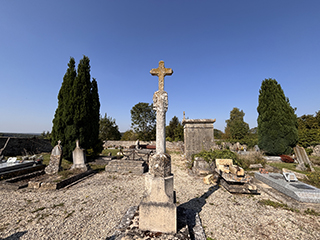
Sentiers du Patrimoine ®
Cherence
Le cimetière de Chérence

Descendre vers le village par la rue des Jardins. Poursuivre par la rue de la Coursoupe. Tourner à gauche pour gagner l’ancien abreuvoir-pédiluve.
Prochain point : Lat. 49.088680, Long.1.676028
The cemetery of Chérence was relocated during the 19th century from its original site near the church to the outskirts of the village along the Route des Crêtes. The cross from the former cemetery, however, has been preserved. Reassembled after the French Revolution from several fragments of an earlier monument, the cross features at the top of its shaft two 16th-century sculptures representing a man and a woman—Saint John the Evangelist and Saint Catherine. The latter can be identified by the wheel, the instrument of her martyrdom. This remarkable and historic cross is officially listed as a Monument Historique.
Over time, Chérence attracted several prominent figures, particularly from the world of the arts, some of whom chose to make it their home. Several now rest in the village cemetery, including the painter Eugène Galien-Laloue (1854–1941), renowned for his depictions of Parisian streets, whose work was highly sought after by collectors in France, Britain, and the United States. The cemetery is also the resting place of Maria McDonald (1893–1987), a translator, and Eugène Jolas (1894–1952), poet, translator, and journalist. This British couple was closely connected to the French avant-garde artists and writers of the 1920s and 1930s and played a key role in translating French authors into English, including Nathalie Sarraute, who is also buried in the Chérence cemetery, alongside her husband Raymond.

